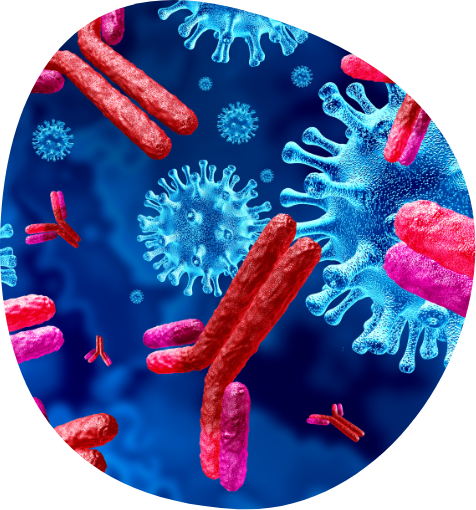The immune system helps the body fight infection.
Usually, when the immune system finds something in the body that doesn’t belong, called an antigen, it launches an immune response (also called an immune attack). During the immune response, many parts of the immune system work together to get rid of the antigen that started the immune attack. If part of the immune system is missing, reduced in number, or not working properly, it causes immunodeficiency.

Understanding Immunodeficiency
Many different cell types make up the immune system. If a certain cell type is missing, reduced in number, or not working properly, it can affect how the body responds to invading antigens.
Sometimes, the cause of immunodeficiency is a genetic mutation. This means that a gene involved with the immune system works differently. The genetic mutation can be inherited from the parents or occur spontaneously. Other times, the cause of immunodeficiency can come from certain illnesses, from taking certain drugs to treat an illness, or from viral infections.
Often, the missing part of the immune system leads to frequent infections that are hard to get rid of.
What is Primary Immunodeficiency?
Primary immunodeficiency (PID) is one of two types of immunodeficiency disorders. It is caused by a genetic mutation, meaning it is present from birth and ongoing. The symptoms often start in childhood, but sometimes it is not diagnosed until adulthood.
More than 300 genetic causes of PID have already been discovered by researchers. About 1 in 1,200 people have some form of PID, and it affects about 29,000 Canadians.
Signs and Symptoms of PID
The signs and symptoms of PID may vary between people because of the many different types of genetic mutations that can cause it. Usually, people with PID have infections that keep coming back, such as ear infections, pneumonia, bronchitis, sinusitis, and skin infections. Eventually, serious bacterial infections can occur that lead to complications.
What is Secondary Immunodeficiency?
Secondary immunodeficiency (SID) is the other type of immunodeficiency. SID results from conditions that are not directly related to the genes of the immune system. SID can occur as part of another disease or as a consequence of certain medications. The most well-known example of SID is the immunodeficiency caused by the Human Immunodeficiency Virus, or HIV. HIV attacks certain cells in the immune system and prevents them from carrying out their proper functions against microbes. When the immune system is sufficiently weakened, infected people catch unusual and severe infections. This is then called the Acquired ImmunoDeficiency Syndrome, or AIDS. AIDS, at this time, is often treated by a specialized multidisciplinary team.
Signs and Symptoms of SID
The signs and symptoms for SID are the same as those for PID, which includes infections that keep coming back, such as ear infections, pneumonia, bronchitis, sinusitis, and skin infections. Eventually, serious bacterial infections can occur that lead to complications.





